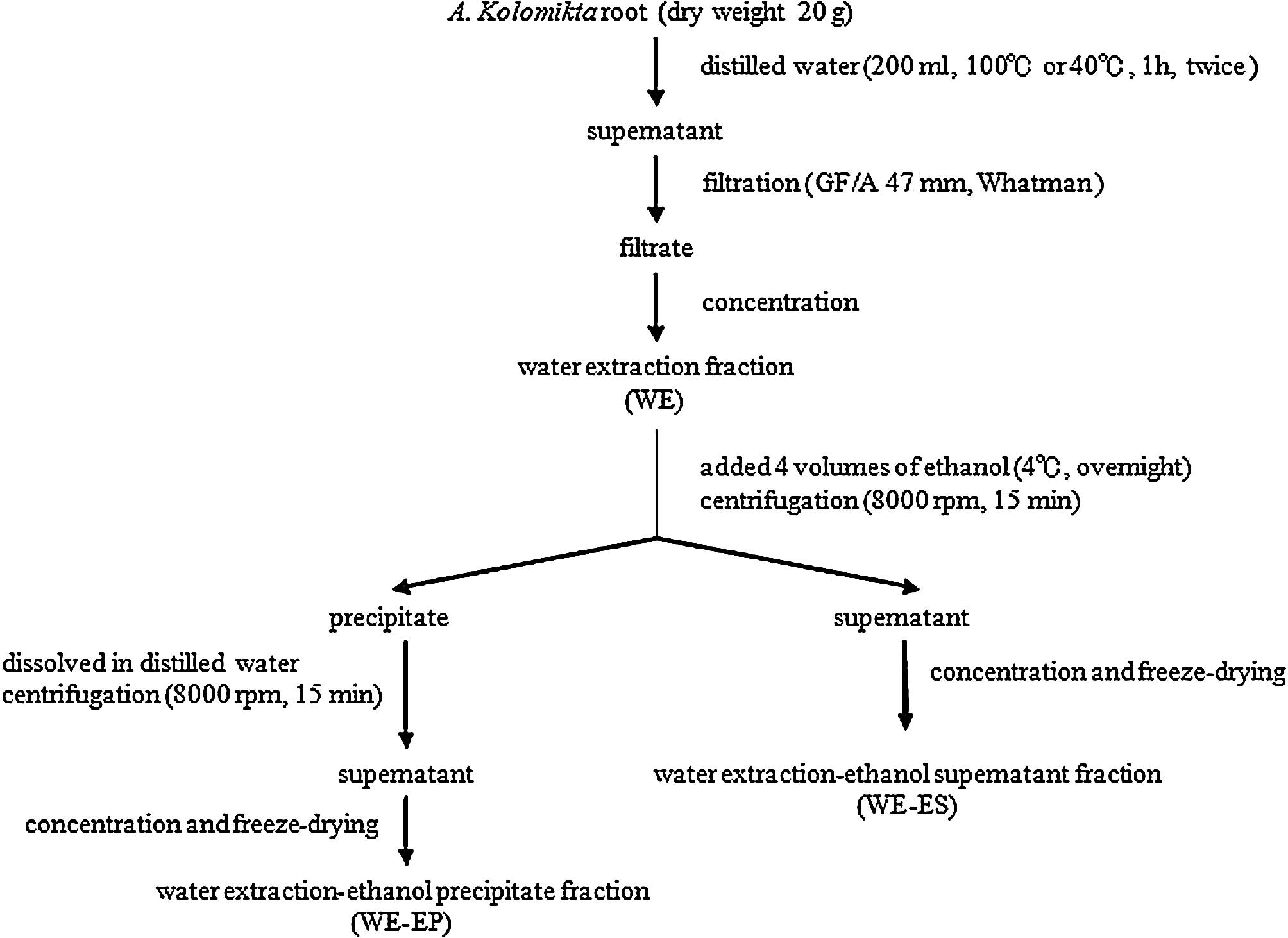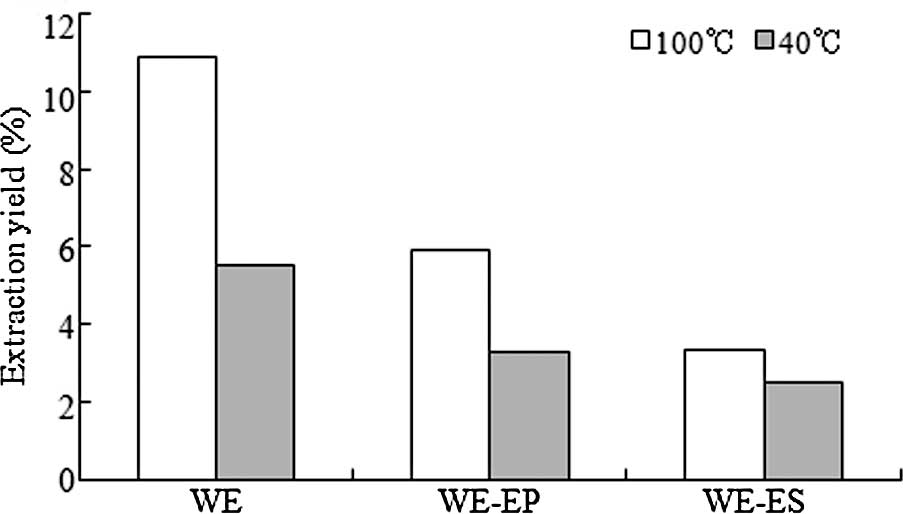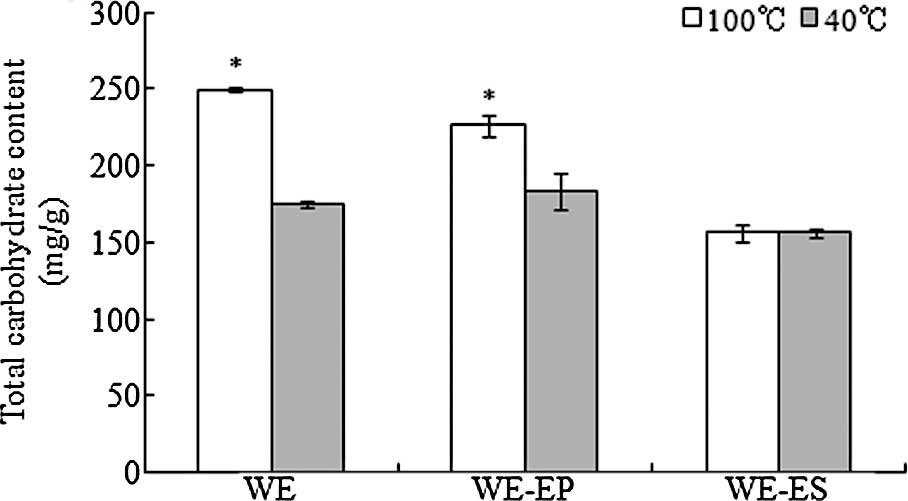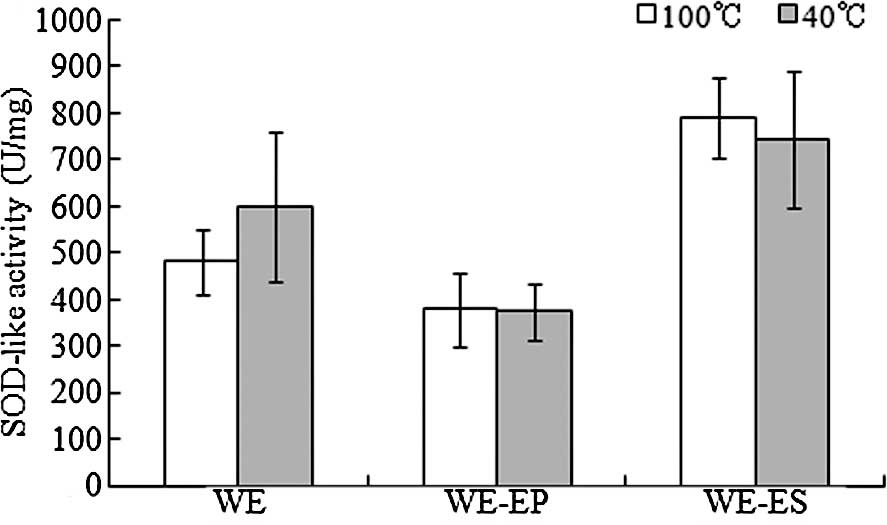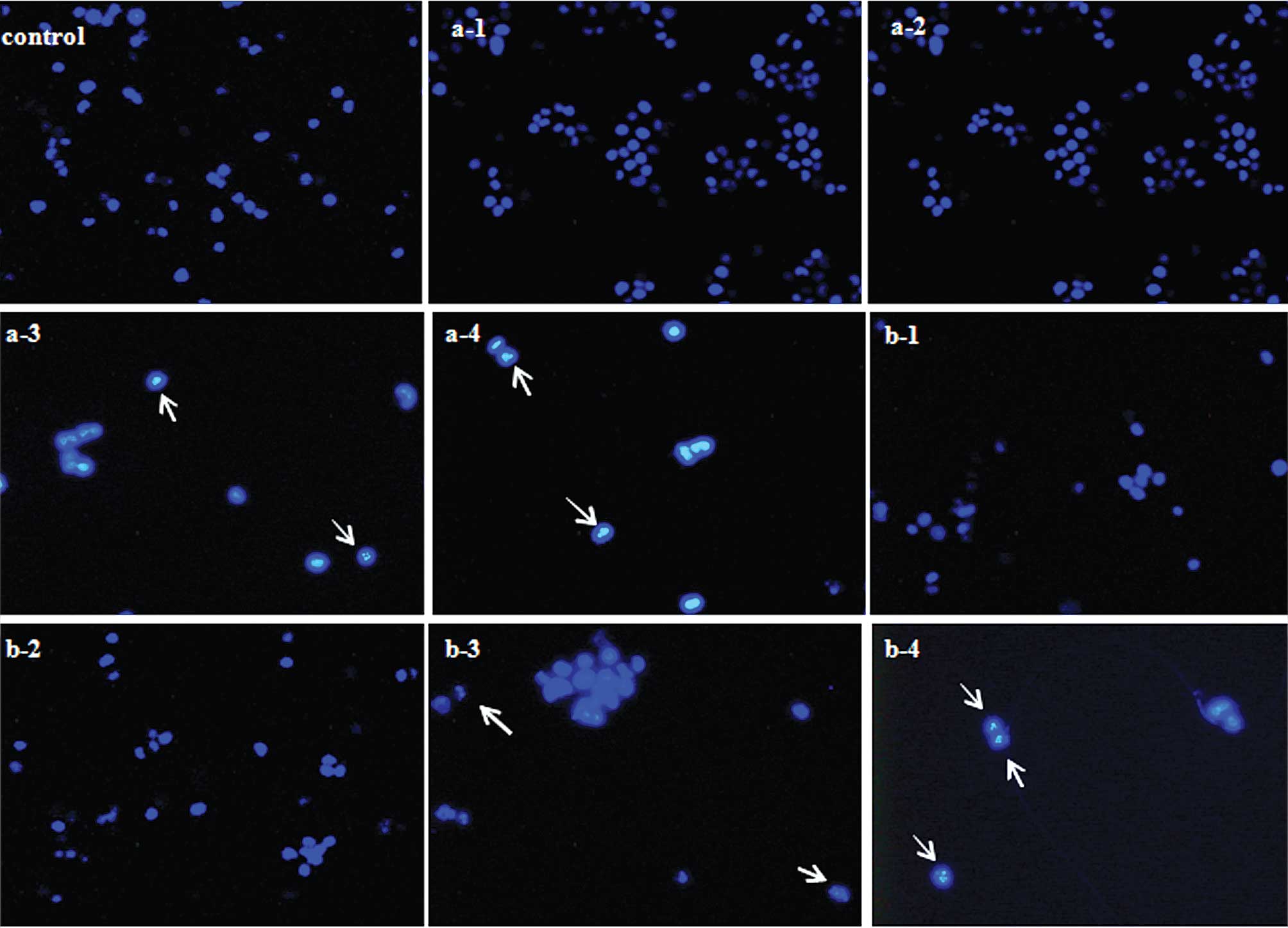Antioxidant and antitumor activities of water extracts from the root of Actinidia kolomikta
- Authors:
- Published online on: November 10, 2010 https://doi.org/10.3892/etm.2010.163
- Pages: 33-39
Abstract
Introduction
Oxidation is an essential biological process for energy production in numerous living organisms. However, excessive reactive oxygen species (ROS) produced in vivo during certain oxidative reactions are strongly associated with the etiology and/or progression of a number of diseases, such as atherosclerosis, cancer and other degenerative diseases, and in aging (1–4). Recently, an increasing number of studies confirm that numerous fruits and vegetables may afford protection against certain chronic diseases caused by oxidative stress since they contain a wide variety of free radical scavenging molecules, such as polyphenols and flavonoids, Vitamin C, carotenoids and tocopherols (5,6), which scavenge radicals by inhibiting initiation and breaking the chain propagation or by suppressing the formation of free radicals by binding to metal ions, reducing hydrogen peroxide and quenching superoxide and singlet oxygen. Thus, these phytochemicals play an important role in the prevention of these diseases (7).
The genus Actinidia consists of over fifty-eight species widely distributed throughout the Asian continent. Specific Actinidia species, such as A. arguta and A. chinensis Planch, are used as health foods and medical agents for cancer treatment (8). It has also been reported that the root of A. eriantha possesses antitumor and immunomodulatory activity (9,10).
Actinidia kolomikta, which grows in the wild throughout the northern part of Indochina, is a locally famous traditional medicine for diabetes. However, there are few studies concerning its bioactivity. The purpose of this study was to investigate the antioxidant and antitumor activity of the vine root extracts processed at high and low water extraction temperatures.
Materials and methods
Chemicals and reagents
2,2-Diphenyl-1-picryl-hydrazyl (DPPH), Folin-Ciocalteu reagent, 6-hydroxy-2,5,7,8-tetramethylchroman-2-carboxylic acid (Trolox), propidium iodide (PI), RPMI-1640 medium, fetal bovine serum (FBS) and penicillin-streptomycin solution were purchased from Sigma-Aldrich, Inc. (St. Louis, MO, USA). The SOD assay kit-WST, Cell counting kit-8 and Hoechst 33258 solution were purchased from Dojindo Molecular Technologies, Inc. (Kumamoto, Japan). Gallic acid was purchased from Nacalai Tesque, Inc. (Kyoto, Japan).
Cell line and culture
The DLD-1 human colon cancer cell line was obtained from the Cell Resource Center for Biomedical Research, Aging and Cancer, Tohoku University, Japan. It was grown in RPMI-1640 medium containing 10% FBS and 1% penicillin/streptomycin. The culture was maintained at 37°C in a humidified 5% CO2 atmosphere (ESPEC CO2 Incubator). The cells were cultured for 2–3 days to reach the logarithmic phase and were then used for the experiment.
Plant material and preparation
The roots of Actinidia kolomikta were collected from the northern part of Indochina. The scheme of the extraction procedure is presented in Fig. 1. For the high temperature extraction, the roots were extracted with distilled water at 100°C for 1 h at a ratio of 1:10 (w/v). The operation was repeated twice. The aqueous extract was centrifuged at 6,000 rpm for 15 min and filtered through a filter paper (GF/A, 47 mm; Whatman, UK). The filtrate was concentrated and lyophilized to obtain the water extraction (WE) fraction. The WE fraction was redissolved in distilled water and was added to four volumes of 99.5% ethanol and then stored at 4°C overnight for precipitation. The precipitate and supernatant were separated and collected by centrifugation at 8,000 rpm for 15 min. The supernatant was concentrated and lyophilized to obtain the water extraction-ethanol supernatant (WE-ES) fraction. The precipitate was washed with 80% ethanol and dissolved in distilled water. After the centrifugation, the supernatant was concentrated and lyophilized to obtain the water extraction-ethanol precipitate (WE-EP) fraction.
The low temperature extraction operation was the same as the high temperature treatment, but distilled water at 40°C was used.
Determination of total carbohydrates and polyphenols
The content of total carbohydrates in the extracts was determined by the phenol-sulfuric acid method (11,12), with glucose as a standard. First, 1 ml of the extraction fraction was collected in glass tubes and 1 ml of 5% phenol solution and 5 ml of concentrated sulphuric acid were added. After mixing for 2 min at room temperature, the tubes were boiled at 100°C for 15 min in a hot water bath. Subsequently, the absorbance was read at 486 nm with a spectrophotometer (HACH, DR/4000 U).
The total polyphenol content was determined using the Folin-Ciocalteu method (3). A volume of 7.9 ml distilled water, 0.1 ml extract fraction and 0.5 ml Folin-Ciocalteu reagent (1:1 with distilled water) were added and mixed in a tube for 1 min. Then, 1.5 ml of sodium carbonate (20 g/100 ml) was added, mixed and allowed to stand for 2 h at room temperature in the dark. The absorbance was read at 765 nm. The total polyphenol content was determined using gallic acid as a standard.
SOD-like activity assay
The levels of SOD-like activity in the extracts were measured using the SOD assay kit-WST according to the technical manual provided by Dojindo Molecular Technologies. Briefly, in a 96-well plate, sample solution (20 μl) was added to each sample and blank 2-well, and 20 μl double-distilled water was added to each blank 1-and blank 3-well. Then, 200 μl of WST working solution was added to each well. After mixing, 20 μl of dilution buffer was added to each blank 2- and blank 3-well, and 20 μl of enzyme working solution was added to each sample- and blank 1-well. The plate was incubated at 37°C for 20 min, and the optical density (OD) was determined at 450 nm, using a microplate reader (Model 550; BioRad, USA). The SOD-like activity was calculated using the following equation: SOD activity (inhibition rate %) = {[(Ablank1-Ablank3)-(Asample-Ablank2)]/(Ablank1-Ablank3)} × 100.
Ablank1, Ablank2, Ablank3 and Asample are the absorbances of blank 1-, blank 2-, blank 3- and sample-wells. The SOD activity (1 unit) was defined as the amount of enzyme having a 50% inhibitory effect on WST-1.
Measurement of the DPPH scavenging activity
The DPPH scavenging activity was measured according to Nakajima et al (13) and Yang et al (14). Volumes of 80 μl of 0.5 mM DPPH in MeOH solutions and 80 μl of 0.1 M MES buffer in 50% MeOH (pH 6.0) were added to a 96-well plate, and an aliquot of sample solution was added for a total volume of 200 μl. After 10 min of reaction, the OD was measured at 570 nm with a microplate reader. The DPPH radical-scavenging activity was calculated using the following equation: DPPH-scavenging activity (%) = (1-Asample/Acontrol) × 100.
The scavenging activity of the sample is expressed as a 50% effective concentration (EC50), which represents the sample concentration (μg/ml) inhibiting 50% of the DPPH radical activity.
Cell proliferation assay
The DLD-1 cells were grown in RPMI-1640 medium at 37°C in a 5% CO2 atmosphere to logarithmic phase. The cells were harvested, and an aliquot (100 μl) of the DLD-1 cell suspension (5×104 cells/ml) was dispensed into a 96-well plate and pre-incubated at 37°C in a 5% CO2 atmosphere for 24 h. The cells were then exposed to various concentrations (25, 50, 100, 200 and 400 μg/ml) of the extracts for 12, 24 and 48 h. After drug exposure, 10 μl of Cell Counting reagent solution was added, and incubation was carried out at 37°C for 4 h. The cell numbers were quantitated by reading the OD at 450 nm.
Flow cytometric assay
The flow cytometric assay was performed according to Zhang et al (15) with some modifications. DLD-1 cells (1×105 cells/ml) were incubated in a 6-well plate with the extracts at concentrations of 25 and 100 μg/ ml for 48 h. The cells were harvested and washed with cold PBS (-) and then fixed in 70% ethanol at 4°C for 4 h. Cells were strained with PI solution (20 μg/ml) at 4°C for 30 min. DNA histograms were generated by flow cytometry (BD LSR; BD Biosciences). Data from 10,000 cells per sample were collected, and the percentage of apoptotic cells was obtained with the CellQuest software (Becton Dickinson).
Nuclear morphological observation
DLD-1 cells (1×105/ml) were incubated in 6-well plate with the extracts at concentrations of 25 and 100 μg/ml for 48 h. The cells were subsequently harvested and stained with Hoechst 33258 (10 μg/ml) for 10 min. Nuclear morphological changes were observed using a Leica fluorescence microscope.
Statistical analysis
Experiments were conducted in triplicate, and the results were expressed as the mean ± SD. Statistical significance was calculated by a two-tailed Student’s t-test (16). p<0.05 was considered significant.
Results
Extraction yield and total polysaccharide and polyphenol contents
The extraction yields are shown in Fig. 2. Yields of WE, WE-EP and WE-ES produced using the 100°C procedure were 10.9, 5.89 and 3.35%, while the yields of the fractions produced using the 40°C procedure reached only 5.53, 3.28 and 2.5%. Thus, the extraction yields produced using the 100°C procedure were higher than those produced using the 40°C extraction procedure.
The total carbohydrate contents are shown in Fig. 3. The total carbohydrate contents of the WE and WE-EP fractions produced using the 100°C extraction procedure were 249.6 and 226.6 mg/g, respectively, which were significantly higher than the total carbohydrate contents of WE (175.1 mg/g) and WE-EP (183.0 mg/g) produced using the 40°C extraction procedure. The results also revealed that the total carbohydrate content in the WE-EP fraction was higher than that in the WE-ES fraction.
The total polyphenol contents are shown in Fig. 4. The polyphenol contents of the WE, WE-EP and WE-ES fractions produced using the 100°C extraction procedure were higher than the polyphenol contents of the fractions produced using 40°C. Moreover, the polyphenol contents of WE and WE-ES produced using the 100°C extraction procedure were significantly higher than those of the extracts produced using the 40°C extraction procedure (p<0.05). The polyphenol content of the WE-ES fraction was higher than that of WE-EP. Data revealed that the polyphenol content of WE-ES produced using the 100°C treatment consisted of 201.9 mg gallic acid/g, which was the highest content compared to all of the other fractions.
SOD-like activity
As shown in Fig. 5, compared to the WE and WE-EP fractions, the WE-ES fraction exhibited a higher antioxidant activity; the SOD-like activities of the WE-ES fraction produced using the 100°C and 40°C extraction procedures were 790.3 and 742.6 U/mg, respectively, while the WE-EP fraction exhibited the lowest SOD-like activities (377.9 and 374.1 U/mg, respectively, for the WE-EP fractions produced using the 100°C and 40°C extraction procedures).
DPPH radical-scavenging activity
The DPPH radical-scavenging activity is shown in Fig. 6. The positive control Trolox revealed the strongest DPPH radical-scavenging activity (EC50, 31.7 μg/ml), and the WE-ES fraction produced using the 100°C extraction procedure had the second strongest radical-scavenging activity (EC50, 87.4 μg/ml). Moreover, all of the fractions (WE, WE-EP and WE-ES) produced using the 100°C extraction procedure revealed significant higher DPPD radical-scavenging activities compared to the fractions produced at 40°C (p<0.05).
Anti-proliferative effects on DLD-1 cells
The WE-EP and WE-ES fractions were used for the experiment of anti-proliferation on the DLD-1 cells (Fig. 7). In this experiment, the extracts at various concentrations (25, 50, 100, 200 and 400 μg/ml) were used. The results revealed that, the higher the concentration of the extract, the lower the cell survival rate. Treatment at the concentration of 400 μg/ml revealed the strongest inhibitory effect on the DLD-1 cells. This suggests that the WE-EP and WE-ES fractions (produced using the 100°C and 40°C extraction procedures) exhibited anti-proliferative effects on DLD-1 cells in a dose-dependent manner. Moreover, the WE-ES fraction inhibited DLD-1 cell proliferation in a time-dependent manner, compared to WE-EP, for which a slight recovery of DLD-1 cell proliferation at 48 h was noted. When DLD-1 cells were treated with the WE-EP and WE-ES fractions for 12 h, a decrease in DLD-1 cell proliferation was noted. However, after the 48-h treatment, the cell survival rates increased in the DLD-1 cells exposed to WE-EP. For example, when the DLD-1 cells were treated with the extracts at the concentration of 400 μg/ml for 24 h, the cell survival rates induced by WE-EP and WE-ES (produced using the 100°C extraction procedure) were 30.7 and 27.0%, respectively. At 48 h, the cell survival rates were 36.5 and 17.35%, respectively. The same trend was observed when cells were treated with fractions produced using the 40°C extraction procedure. Based on these results, the anti-proliferative effect of the WE-ES fraction was stronger than that of WE-EP.
Apoptosis assay
Results of the apoptosis assay are shown in Fig. 8. When the DLD-1 cells were treated with the WE-EP fraction (produced using the 100°C extraction procedure) at concentrations of 25 and 100 μg/ml for 48 h, the percentage of apoptotic cells decreased from 1.24 to 0.8% while the percentage increased from 0.94 to 1.72% upon treatment of WE-EP produced using the 40°C extraction procedure). These data did not reveal a significant increase. In comparison with the WE-EP treatment, when DLD-1 cells were exposed to WE-ES (produced using the 100°C extraction procedure) at concentrations of 25 and 100 μg/ml for 48 h, the percentage of apoptotic cells increased from 3.26 to 25.68% while the percentage of apoptotic cells increased from 6.09 to 24.25% when treated with WE-ES produced at 40°C. This suggests that WE-ES induces DLD-1 cell apoptosis in a dose-dependent manner.
Changes in apoptotic cell morphology
The criteria used to identify pro-apoptosis includes nuclear shrinkage and chromatin condensation (17). As shown in Fig. 9, nuclear fragmentation was clearly noted when the DLD-1 cells were exposed to WE-ES (25 and 100 μg/ml) for 48 h, while upon treatment with WE-EP at 25 and 100 μg/ml for 48 h, apoptotic cells were hardly observed.
Discussion
The extraction yields and the polysaccharide and polyphenol contents of the extracts produced using the 100°C procedure were higher than those of the extracts produced using the 40°C treatment. The total carbohydrate content of the WE-EP fraction was significantly higher than that of the WE-ES fraction. Since polysaccharides do not dissolve in 80% ethanol, WE-EP can be considered as a crude polysaccharide fraction. However, based on the results (Fig. 4), the WE-EP fraction still contained a certain amount of polyphenols. On the other hand, the polyphenol content of the WE-ES fraction was higher than that of WE-EP, but there were also some polysaccharides in the WE-ES fraction. Thus, crude polysaccharides were mostly contained in the WE-EP fraction, while in the WE-ES fraction, the polyphenol content was marked. Plant polysaccharides and polyphenols are antioxidants (18), and they scavenge radicals by inhibiting initiation and breaking chain propagation by suppressing formation of free radicals by binding to metal ions, reducing hydrogen peroxide and quenching superoxide and singlet oxygen. In this study, the WE-EP and WE-ES fractions exhibited SOD-like activity and DPPH radical-scavenging activity, while the WE-ES fraction revealed higher antioxidant activity than WE-EP. It has been reported that polyphenols are strong radical scavengers and metal chelators in model chemical systems (19). Furthermore, it has been reported that there is a positive significant linear relationship between antioxidant activity and total polyphenol content; polyphenols are the dominant antioxidant components in medicinal herbs (20). As our data revealed, WE-ES produced using the 100°C extraction procedure exhibited the highest polyphenol content (Fig. 4) and the highest SOD-like activity and DPPH radical-scavenging activity (Figs. 5 and 6). Thus, the high polyphenol content in the WE-ES fraction resulted in the high antioxidant activity. In the present study, compared to the 40°C extraction procedure, the 100°C extraction process was more effective at extracting polysaccharides and polyphenols to obtain a higher antioxidant content. This finding is similar to that in the study of Sousa et al (21).
The four extracts, WE-EP and WE-ES produced using 100°C and 40°C extraction procedures, were used for evaluating the anti-proliferative effect on DLD-1 cells. All of the fractions inhibited DLD-1 cell proliferation, and their anti-proliferative effect was in a dose-dependent manner. Furthermore, WE-ES inhibited DLD-1 cell proliferation in a time-dependent manner, compared to WE-EP, for which a slight recovery of DLD-1 cell proliferation at 48 h was noted. Further purification steps with DEAE Sephadex A-50 column chromatography on WE-EP (crude polysaccharide fraction) revealed that the high concentration of purified polysaccharides did not exhibit a significant anti-proliferative effect on DLD-1 cells (data not shown). This suggests that the polyphenols in the fractions conferred the main inhibitory effect on DLD-1 cell proliferation. Recently, it was reported that several plant-derived polyphenols may possess antioxidant, antitumor and apoptosis-inducing properties (22). For example, HL-60 cells treated with tea polyphenols were found to undergo morphological changes and chromatin fragmention characteristic of apoptosis (23). Apoptosis is the process of programmed cell death that occurs in multicellular organisms. Biochemical events lead to characteristic cell changes (morphology) and cell death. These changes include blebbing, loss of cell membrane asymmetry and attachment, cell shrinkage, nuclear fragmentation, chromatin condensation and chromosomal DNA fragmentation. Induction of apoptosis is thus considered as a strategy for cancer control. In this study, treatment with WE-EP revealed no significant changes in the percentage of apoptotic cells. In contrast, treatment with WE-ES resulted in an increase in apoptotic cells. Thus, the apoptosis-inducing effect of WE-ES on DLD-1 cells occurs in a dose-dependent manner. Furthermore, based on the results of nuclear morphological changes, nuclear fragmentation was only clearly observed when DLD-1 cells were exposed to the WE-ES fraction (25 and 100 μg/ml) for 48 h. Thus, these results suggest that the WE-ES fraction inhibits the proliferation of DLD-1 cells by the induction of apoptosis.
Future studies are required to purify and analyze the active components of WE-ES. Polysaccharides are reported to play an important role in the immune system, and they are currently believed to confer an antitumor effect by stimulating the host immunomodulatory activity and enhancing the host immune response to inhibit tumor growth (24). Thus, it is considered that polysaccharides have an indirect inhibitory effect on cancer cells. Thus, our future study will examine the immunomodulatory activity of WE-EP on macrophages.
In conclusion, in this study, the water extracts from the root of A. kolomikta exhibited antioxidant activities and inhibitory effects on DLD-1 colon cancer cell proliferation. Moreover, WE-ES clearly inhibited the proliferation of DLD-1 cells by inducing apoptosis. Medicinal plant extracts are considered as non-toxic and do not cause major side effects. Actinidia kolomikta is a species of wild plant which is widely distributed throughout Asia. This initial study on the bioactivity of wild Actinidia kolomikta supports its potential use in cancer therapies or as a natural health food with antioxidant actions.
Acknowledgements
The materials were collected from their natural habitat by Dr Keo Intabon, Graduate School of Life and Environmental Sciences, University of Tsukuba, Japan.
References
|
Moskovitz J, Yim MB and Chock PB: Free radicals and disease. Arch Biochem Biophys. 397:354–359. 2002. View Article : Google Scholar : PubMed/NCBI | |
|
Sun J, Yao JY, Huang SX, Long X, Wang JB and Garcia EG: Antioxidant activity of polyphenol and anthocyanin extracts from fruits of Kadsura coccinea (Lem). Food Chem. 117:276–281. 2009. View Article : Google Scholar | |
|
Mau JL, Lin HC and Song SF: Antioxidant properties of several specialty mushrooms. Food Res Int. 35:519–526. 2002. View Article : Google Scholar | |
|
Hu TJ, Wei XJ, Zhang X, Cheng FS, Shuai XH, Zhang L and Kang L: Protective effect of Potentilla anserine polysaccharide (PAP) on hydrogen peroxide induced apoptosis in murine splenic lymphocytes. Carbohydr Polym. 79:356–361. 2010. View Article : Google Scholar | |
|
PJiménez J, Arranz S, Tabernero M, Díaz-Rubio ME, Serrano J, Goñi I and Saura-Calixto F: Updated methodology to determine antioxidant capacity in plant foods, oils and beverages: Extraction, measurement and expression of results. Food Res Int. 41:274–285. 2008. | |
|
Hadi SM, Bhat SH, Azmi AS, Hanif S, Shamim U and Ullah MF: Oxidative breakage of cellular DNA by plant polyphenols: A putative mechanism for anticancer properties. Semin Cancer Biol. 17:370–376. 2007. View Article : Google Scholar : PubMed/NCBI | |
|
Du GR, Li MJ, Ma FW and Liang D: Antioxidant capacity and the relationship with polyphenol and Vitamin C in Actinidia fruits. Food Chem. 113:557–562. 2009. View Article : Google Scholar | |
|
Graham JG, Quinn ML, Fabricant DS and Farnsworth NR: Plants used against cancer – an extension of the work of Jonathan Hartwell. J Ethnopharmacol. 73:347–377. 2000. | |
|
Xu HS, Yao L, Sun HX and Wu YW: Chemical composition and antitumor activity of different polysaccharides from the roots of Actinidia eriantha. Carbohydr Polym. 78:316–322. 2009. View Article : Google Scholar | |
|
Xu HS, Wu YW, Xu SF, Sun HX, Chen FY and Yao L: Antitumor and immunomodulatory activity of polysaccharides from the roots of Actinidia eriantha. J Ethnopharmacol. 125:310–317. 2009. View Article : Google Scholar : PubMed/NCBI | |
|
Mauro M: Estimation of total carbohydrate amount in environmental samples by the phenol-sulphuric acid method assisted by multivariate calibration. Chemom Intell Lab Syst. 79:84–90. 2005. View Article : Google Scholar | |
|
Rhee SJ, Cho SY, Kim KM, Cha DS and Park HJ: A comparative study of analytical methods for alkali-soluble β-glucan in medicinal mushroom, Chaga (Inonotus obliquus). LWT-Food Sci Technol. 41:545–549. 2008. | |
|
Nakajima Y, Sato Y and Konishi T: Antioxidant small phenolic ingredients in Inonotus obliquus (persoon) Pilat (Chaga). Chem Pharm Bull. 55:1222–1226. 2007. View Article : Google Scholar : PubMed/NCBI | |
|
Yang B, Wang JS, Zhao MM, Liu Y, Wang W and Jiang YM: Identification of polysaccharides from pericarp tissues of litchi (Litchi chinensis Sonn) fruit in relation to their antioxidant activities. Carbohydr Res. 341:634–638. 2006. View Article : Google Scholar : PubMed/NCBI | |
|
Zhang M, Chen HX, Huang J, Li Z, Zhu CP and Zhang SH: Effect of lycium barbarum polysaccharide on human hepatoma QGY7703 cells: inhibition of proliferation and induction of apoptosis. Life Sci. 76:2115–2124. 2005. | |
|
Hu HH, Zhang ZY, Lei ZF, Yang YN and Sugiura N: Comparative study of antioxidant activity and antiproliferative effect of hot water and ethanol extracts from the mushroom Inonotus obliquus. J Biosci Bioeng. 107:42–48. 2009. View Article : Google Scholar : PubMed/NCBI | |
|
Bennani H, Drissi A, Giton F, Kheuang L, Fiet J and Adlouni A: Antiproliferative effect of polyphenols and sterols of virgin argan oil on human prostate cancer cell lines. Cancer Detect Prev. 31:64–69. 2007. View Article : Google Scholar : PubMed/NCBI | |
|
Wang ZJ and Luo DH: Antioxidant activities of different fractions of polysaccharide purified from Gynostemma pentaphyllum Makino. Carbohydr Polym. 68:54–58. 2007. View Article : Google Scholar | |
|
Su XG, Duan J, Jiang YM, Shi J and Kakuda Y: Effects of soaking conditions on the antioxidant potentials of oolong tea. J Food Compos Anal. 19:348–353. 2006. View Article : Google Scholar | |
|
Cai YZ, Luo Q, Sun M and Corke H: Antioxidant activity and phenolic compounds of 112 traditional Chinese medicinal plants associated with anticancer. Life Sci. 74:2157–2184. 2004. View Article : Google Scholar : PubMed/NCBI | |
|
Sousa A, Ferreira ICFR, Barros L, Bento A and Alberto J: Pereira effect of solvent and extraction temperatures on the antioxidant potential of traditional stoned table olives “alcaparras”. LWT-Food Sci Technol. 41:739–745. 2008. | |
|
Kilani-Jaziri S, Neffati A, Limem I, Boubaker J, Skandrani I, Sghair MB, Bouhlel I, Bhouri W, Mariotte AM, Ghedira K, Franca MD and Chekir-Ghedira L: Relationship correlation of antioxidant and antiproliferative capacity of Cyperus rotundus products towards K562 erythroleukemia cells. Chem-Biol Interact. 181:85–94. 2009. View Article : Google Scholar : PubMed/NCBI | |
|
Zhao Y, Cao J, Ma H and Liu JW: Apoptosis induced by tea polyphenols in HL-60 cells. Cancer Lett. 121:163–167. 1997. View Article : Google Scholar : PubMed/NCBI | |
|
Han SB, Park SK, Ahn HJ, Yoon YD, Kim YH, Lee JJ, Lee KH, Moon JS, Kim HC and Kim HM: Characterization of B cell membrane receptors of polysaccharide isolated from the root of Acanthopanax koreanum. Int Immunopharmacol. 3:683–691. 2003. View Article : Google Scholar : PubMed/NCBI |



